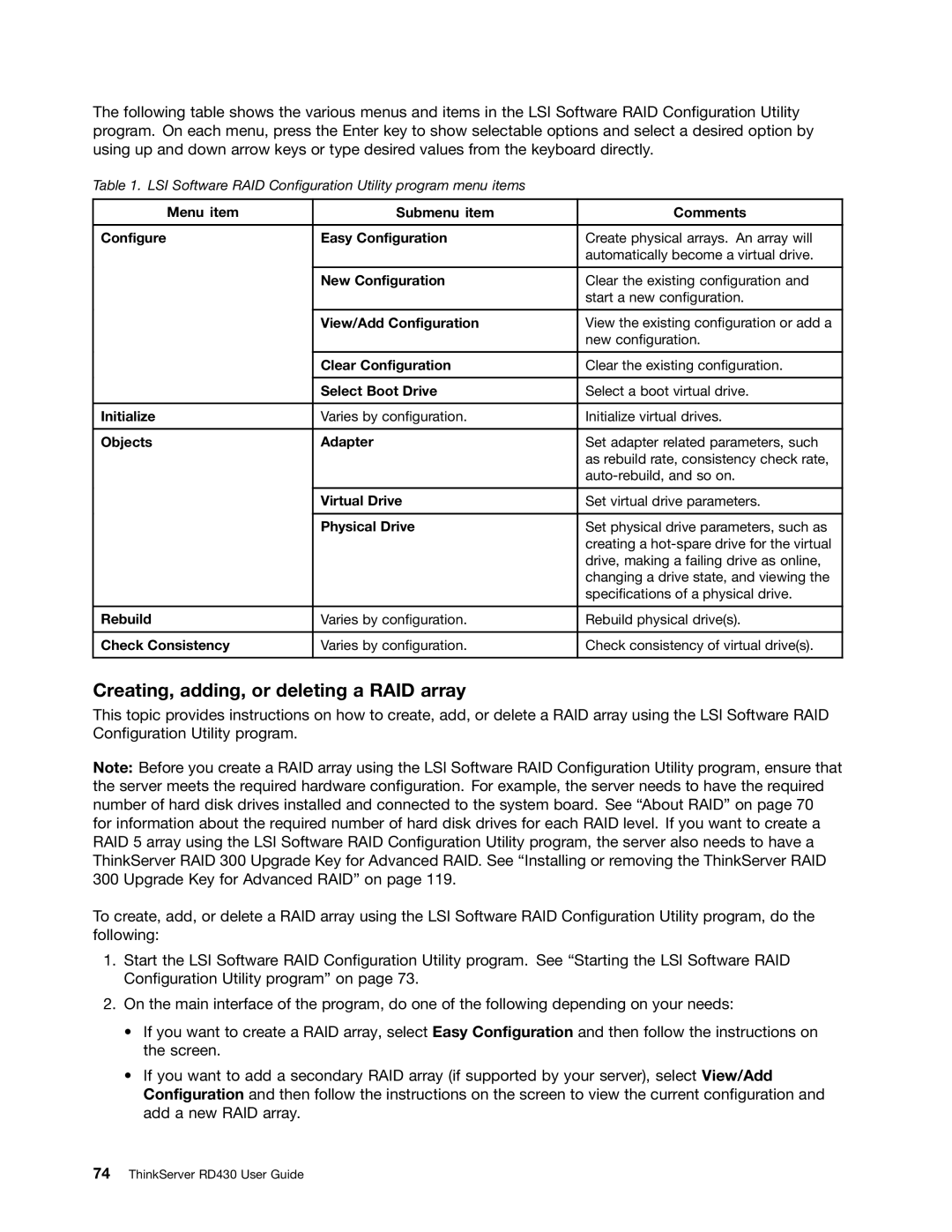The following table shows the various menus and items in the LSI Software RAID Configuration Utility program. On each menu, press the Enter key to show selectable options and select a desired option by using up and down arrow keys or type desired values from the keyboard directly.
Table 1. LSI Software RAID Configuration Utility program menu items
Menu item | Submenu item | Comments |
|
|
|
Configure | Easy Configuration | Create physical arrays. An array will |
|
| automatically become a virtual drive. |
|
|
|
| New Configuration | Clear the existing configuration and |
|
| start a new configuration. |
|
|
|
| View/Add Configuration | View the existing configuration or add a |
|
| new configuration. |
|
|
|
| Clear Configuration | Clear the existing configuration. |
|
|
|
| Select Boot Drive | Select a boot virtual drive. |
|
|
|
Initialize | Varies by configuration. | Initialize virtual drives. |
|
|
|
Objects | Adapter | Set adapter related parameters, such |
|
| as rebuild rate, consistency check rate, |
|
| |
|
|
|
| Virtual Drive | Set virtual drive parameters. |
|
|
|
| Physical Drive | Set physical drive parameters, such as |
|
| creating a |
|
| drive, making a failing drive as online, |
|
| changing a drive state, and viewing the |
|
| specifications of a physical drive. |
|
|
|
Rebuild | Varies by configuration. | Rebuild physical drive(s). |
|
|
|
Check Consistency | Varies by configuration. | Check consistency of virtual drive(s). |
|
|
|
Creating, adding, or deleting a RAID array
This topic provides instructions on how to create, add, or delete a RAID array using the LSI Software RAID Configuration Utility program.
Note: Before you create a RAID array using the LSI Software RAID Configuration Utility program, ensure that the server meets the required hardware configuration. For example, the server needs to have the required number of hard disk drives installed and connected to the system board. See “About RAID” on page 70 for information about the required number of hard disk drives for each RAID level. If you want to create a RAID 5 array using the LSI Software RAID Configuration Utility program, the server also needs to have a ThinkServer RAID 300 Upgrade Key for Advanced RAID. See “Installing or removing the ThinkServer RAID 300 Upgrade Key for Advanced RAID” on page 119.
To create, add, or delete a RAID array using the LSI Software RAID Configuration Utility program, do the following:
1.Start the LSI Software RAID Configuration Utility program. See “Starting the LSI Software RAID Configuration Utility program” on page 73.
2.On the main interface of the program, do one of the following depending on your needs:
•If you want to create a RAID array, select Easy Configuration and then follow the instructions on the screen.
•If you want to add a secondary RAID array (if supported by your server), select View/Add Configuration and then follow the instructions on the screen to view the current configuration and add a new RAID array.
